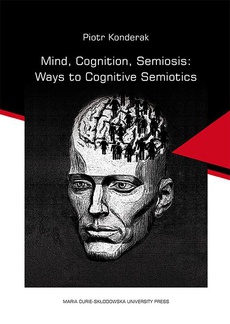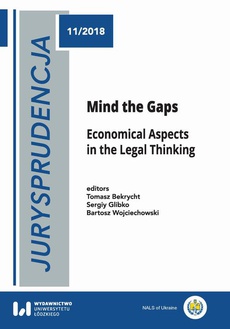POLECAMY

Mind, Cognition, Semiosis: Ways to Cognitive Semiotics
Autor:
Format:
pdf, ibuk
What is meaning-making? How do new domains of meanings emerge in the course of child’s development? What is the role of consciousness in this process? What is the difference between making sense of pointing, pantomime and language utterances? Are great apes capable of meaning-making? What about dogs? Parrots? Can we, in any way, relate their functioning and behavior to a child’s? Are artificial systems capable of meaning-making?
The above questions motivated the emergence of cognitive semiotics as a discipline devoted to theoretical and empirical studies of meaning-making processes. As a transdisciplinary approach to meaning and meaning-making, cognitive semiotics necessarily draws on a different disciplines: starting with philosophy of mind, via semiotics and linguistics, cognitive science(s), neuroanthropology, developmental and evolutionary psychology, comparative studies, and ending with robotics.
The book presents extensively this discipline. It is a very eclectic story: highly abstract problems of philosophy of mind are discussed and, simultaneously, results of very specific experiments on picture recognition are presented. On the one hand, intentional acts involved in semiotic activity are elaborated; on the other, a computational system capable of a limited interpretation of excerpts from Carroll’s Through the Looking-Glass is described. Specifically, the two roads to cognitive semiotics are explored in the book: phenomenological-enactive path developed by the so-called Lund school and author’s own proposal: a functional-cognitivist path.
| Rok wydania | 2018 |
|---|---|
| Liczba stron | 320 |
| Kategoria | Językoznawstwo |
| Wydawca | Wydawnictwo Uniwersytetu Marii Curie-Skłodowskiej |
| ISBN-13 | 978-83-227-9085-4 |
| Numer wydania | 1 |
| Informacja o sprzedawcy | ePWN sp. z o.o. |
Ciekawe propozycje
Spis treści
| Introduction: How to Approach Meaning? | 9 |
| Acknowledgements 17 | |
| Part I. Cognitive Semiotics: The Basics 19 | |
| Chapter 1. Introducing Cognitive Semiotics | 21 |
| 1.1 The beginnings | 21 |
| 1.2 Extension of the term “semiotics” | 24 |
| 1.3 Methodology of cognitive semiotics | 26 |
| 1.4 Transdisciplinarity | 29 |
| 1.5 Phenomenological contributions | 30 |
| 1.6 “Third stage” of cognitive science | 31 |
| 1.7 Key research interests | 32 |
| 1.7.1 Metatheoretical considerations | 32 |
| 1.7.2 Semiotic development and evolution | 33 |
| 1.7.3 Multimodality and gestures | 37 |
| 1.8 Cognitive semiotics and cognitivism | 38 |
| Chapter 2. The Semiotic Hierarchy Framework | 41 |
| 2.1 Meaning theory – initial remarks | 41 |
| 2.2 The Semiotic Hierarchy as a theory of meaning | 43 |
| 2.2.1 Level 1: Life | 43 |
| 2.2.2 Level 2: Consciousness | 45 |
| 2.2.3 Between life and consciousness: the first transition | 46 |
| 2.2.4 Level 3: Signs | 48 |
| 2.2.5 Between consciousness and signs: the second transition | 49 |
| 2.2.6 Level 4: Language | 50 |
| 2.2.7 From signs to language: the third transition | 52 |
| 2.3 The Semiotic Hierarchy: some objections | 54 |
| Part II. Minds and Meanings | 61 |
| Chapter 3. “Analytic” Philosophy of Mind | 63 |
| 3.1 The Cartesian heritage | 63 |
| 3.2 Meaningful behavior | 66 |
| 3.2.1 Behaviorism and cognitive semiotics: mind, body, behavior | 70 |
| 3.2.2 Problem of other minds | 70 |
| 3.2.3 First-person knowledge | 71 |
| 3.3 Reduction to the neural: meaning in the brain | 72 |
| 3.3.1 Phenomenological fallacy and other problems | 73 |
| 3.4 Meaning and function | 75 |
| 3.4.1 On the way to functionalism: causal profiles | 75 |
| 3.4.2 Mind and function | 76 |
| 3.4.3 Qualia | 79 |
| 3.4.4 The representational theory of mind | 80 |
| 3.4.5 Functionalism extended | 82 |
| 3.4.6 Functionalism and cognitive semiotics | 84 |
| 3.4.7 Extended mind and meaning-making | 86 |
| 3.5 Consciousness, functionally understood | 87 |
| 3.6 The subjective mind | 90 |
| Chapter 4. The Phenomenological Mind and Meaning-Making | 93 |
| 4.1 How should phenomenology be approached? | 93 |
| 4.2 Intentionality | 95 |
| 4.2.1 Perception | 97 |
| 4.2.2 Remembering | 101 |
| 4.2.3 Imagination and anticipation | 103 |
| 4.2.4 Signitive intentions | 103 |
| 4.2.5 Pictorial intention | 105 |
| 4.2.6 Indicational intentions | 106 |
| 4.2.7 Categorial intentions | 107 |
| 4.2.8 Types of intentionality and the Semiotic Hierarchy | 109 |
| 4.3 So where are meanings? | 109 |
| 4.4 The phenomenological method | 111 |
| 4.5 Lifeworld | 115 |
| 4.6 Intersubjectivity | 116 |
| 4.7 Embodiment | 119 |
| 4.8 A way to science | 120 |
| 4.9 Phenomenology applied | 122 |
| 4.9.1 Neurophenomenology | 122 |
| 4.9.2 Front-loading phenomenology | 124 |
| 4.9.3 A note on heterophenomenology | 126 |
| 4.10 Summary: taking phenomenology seriously | 127 |
| Part III. Cognition | 133 |
| Chapter 5. Cognitivist Approach to Cognition | 135 |
| 5.1 “Cognitivism” or standard cognitive science | 135 |
| 5.2 Symbolic approach: the three basic ideas | 136 |
| 5.2.1 Limitations: magical number 7 | 137 |
| 5.2.2 The generative approach to language | 138 |
| 5.2.3 TOTE: organization of behavior and behind behavior | 140 |
| 5.2.4 Cognitivism in a nutshell: perception | 141 |
| 5.3 Connectionist approaches | 143 |
| 5.3.1 Overview of the architecture | 144 |
| 5.3.2 Connectionist representations | 145 |
| 5.3.3 Manipulations on representations | 147 |
| 5.4 Representations revisited | 148 |
| 5.5 What cognitive science is supposed not to be | 149 |
| 5.6 Standard cognitive science and meaning-making | 151 |
| 5.7 Cognitivism – summary | 153 |
| 5.8 Departure from cognitivism: dynamical systems | 154 |
| 5.8.1 Dynamical systems – applications | 156 |
| Chapter 6. Beyond Cognitivism? | 159 |
| 6.1 Problems with cognitivism | 159 |
| 6.2 The enactive approach: cognition as interaction | 160 |
| 6.2.1 Meaning-making in perception I: Gibson’s ecological psychology | 163 |
| 6.2.2 Meaning-making in perception II: “skillful bodily activity” | 167 |
| 6.2.3 Experiences | 169 |
| 6.2.4 Foundations of meaning: autonomy and sense-making | 170 |
| 6.2.5 Consciousness and phenomenology | 172 |
| 6.2.6 Radical enactivism: Hutto and Myin | 173 |
| 6.2.7 Enactivism in cognitive semiotics | 175 |
| 6.3 Embodied cognition | 175 |
| 6.3.1 The two approaches to embodiment | 178 |
| 6.3.2 Embodiment in practice | 179 |
| 6.3.3 How to overcome the limitations? | 181 |
| 6.3.4 Six faces of embodiment | 183 |
| 6.3.5 Summarizing embodiment | 184 |
| 6.4 Extended cognition | 185 |
| 6.4.1 Constitution and the cognitive | 186 |
| 6.4.2 What is a cognitive system? | 187 |
| 6.5 The embedded mind: a short note | 190 |
| 6.6 4e+a (or rather 2e+a) | 191 |
| 6.7 Representations | 196 |
| 6.7.1 Representations and cognitive semiotics | 199 |
| 6.8 Summary: cognitive science, cognitive sciences | 200 |
| Part IV. Semiosis 207 | |
| Chapter 7. Towards a Semiotics for Cognitive Semiotics | 209 |
| 7.1 Semiotics, sign, semiosis | 209 |
| 7.2 What is a sign: The Stoics | 210 |
| 7.2.1 Kinds of signs | 210 |
| 7.2.2 Sign, proposition and conditional | 211 |
| 7.2.3 Signs and language | 212 |
| 7.2.4 “Reading the world”: semeia and cognitive semiotics | 213 |
| 7.3 Peircean semiotics | 214 |
| 7.3.1 Signs and cognition | 215 |
| 7.3.2 Sign, the definition(s) | 217 |
| 7.3.3 Peircean semiosis as meaning-making | 221 |
| 7.3.4 The second trichotomy | 222 |
| 7.3.5 Meanings beyond signs | 225 |
| 7.3.6 Peircean cognitive semiotics | 226 |
| 7.4 Semiotics for cognitive semiotics: Sonesson | 227 |
| 7.4.1 Perceptual meaning | 227 |
| 7.4.2 Sonesson’s notion of a sign | 228 |
| 7.4.3 Phenomenology and semiotics | 231 |
| 7.5 Semiotics and empirical studies | 234 |
| 7.5.1 Emergence of sign function empirically addressed | 235 |
| 7.5.2 Semiotics for cognitive semiotics: applications | 237 |
| 7.5.2.1 Study I: understanding iconicity | 238 |
| 7.5.2.2 Study II: the role of semiotic vehicles in communication | 239 |
| 7.6 In sum: the conceptual-empirical spiral | 241 |
| Chapter 8. Cognitivism: Modeling Semiosis | 243 |
| 8.1 Back to cognitivism: a method | 243 |
| 8.1.1 Cognitive architectures | 244 |
| 8.1.2 Cognitive modeling: an example application | 246 |
| 8.1.3 Cognitive (computational) modeling | 248 |
| 8.2 Cognitive modeling of semiosis | 250 |
| 8.2.1 What is modeled: semiotic systems | 251 |
| 8.2.2 Approaches to semiosis | 253 |
| 8.2.3 Cognitive architecture for semiosis: GLAiR & snarpy | 255 |
| 8.2.4 Semiosis implemented | 257 |
| 8.2.5 Further observations | 266 |
| 8.2.6 Re-interpretation | 271 |
| 8.2.7 Using a sign as a sign | 273 |
| 8.3 Summary: cognitive modeling of meaning-making | 275 |
| Concluding Remarks: Ways to Cognitive Semiotics Reconsidered | 277 |
| Common starting point | 277 |
| Complications on the road | 279 |
| The forking of paths | 281 |
| On the cognitivist path | 281 |
| Back on the common road? | 283 |
| What’s on the horizon | 283 |
| Cognitivism on the horizon | 285 |
| The last signpost on the road | 286 |
| References | 287 |
| Index of Names | 309 |
| Index of Subjects | 313 |
























